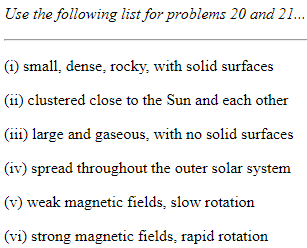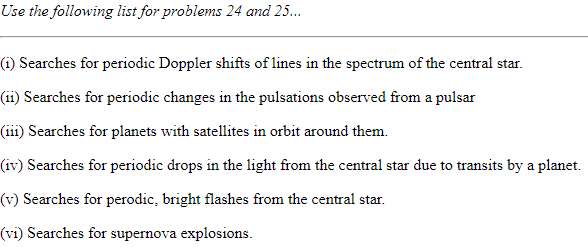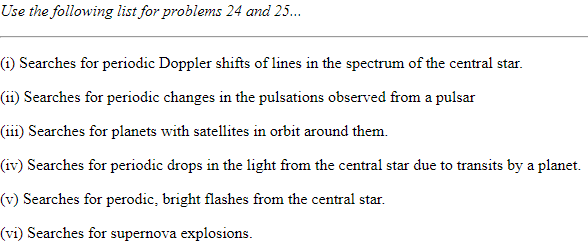Astronomy test #2
1/29
There's no tags or description
Looks like no tags are added yet.
Name | Mastery | Learn | Test | Matching | Spaced |
|---|
No study sessions yet.
30 Terms
Seismic ________ waves cannot propagate through the Earth's core, while seismic ________ waves can.
shear; pressure
The theoretical resolution of a telescope in arc-seconds is given by
a = 2.5 x 10^-5 (lambda / D)
where lambda is the wavelength of the radiation in Angstroms and D is the diameter of the primary mirror or lens in meters. If we ________ the value of lambda while leaving D fixed, then the resolution angle a is ________
double; doubled.
The theoretical resolution in arc-seconds for a radio telescope with a diameter D = 10^4 meters observing at a wavelength of 10^8 Angstroms is ________. This telescope would make observations with a resolution of ________ if it were located on the Moon's surface, and observations with a resolution of ________ if it were located on the Earth's surface.
0.25 arc-seconds; 0.25 arc-seconds; 0.25 arc-seconds
The theoretical resolution in arc-seconds for an optical telescope with a diameter D = 5 meters observing at a wavelength of 10^4 Angstroms is ________. This telescope would make observations with a resolution of ________ if it were located on the Moon's surface, and observations with a resolution of ________ if it were located on the Earth's surface.
0.05 arc-seconds; 0.05 arc-seconds; 1 arc-second
Interferometry is the process that uses two or more small telescopes separated by a large distance to
improve the resolution to that of a telescope with a size equal to the distance between the telescopes.
Atmospheric blurring is due to
turbulent motions in the Earth's atmosphere
If the concentration of CO2 in a planet's atmosphere increases,
the surface temperature increases because the additional CO2 acts like an extra blanket
A hot, dense gas at high pressure produces
a continuous spectrum
Atoms can be excited as a result of ________.
collisions with other atoms AND absorption of radiation (both a+c)
The energy values for the electronic excitation levels in an atom are determined by
the number of protons in its nucleus.
A hot, thin gas produces ________. Emission and absorption lines can be broadened due to ________.
emission lines; high temperature and strong rotation
We know that according to the Doppler formula, the observed wavelength lambda_observed for a spectral line is related to the emitted wavelength lambda_emitted by the formula
(lambda_observed / lambda_emitted) = 1 + (v / c)
where c = 3 x 10^10 cm per second is the speed of light and v is the velocity of recession. If the emitted and observed wavelengths of the lines are given by
lambda_observed = 5,360 Angstroms, lambda_emitted = 4,102 Angstroms
lambda_observed = 5,672 Angstroms, lambda_emitted = 4,341 Angstroms
lambda_observed = 6,352 Angstroms, lambda_emitted = 4,861 Angstroms
lambda_observed = 8,576 Angstroms, lambda_emitted = 6,563 Angstroms
away from us; 9.2 x 10^9 cm per second
The highest high tides occur when
the Earth, Moon, and Sun form a line.
The lowest high tides occur when
the Earth, Moon and Sun form a right triangle.
Uranium 238 has a half-life of about 4 billion years and decays into lead. How long will it take for 7/8 of the Uranium to change into lead?
12 billion years
If two planets with the same mass but different temperatures start off with the same amount of hydrogen gas in their atmospheres, then the ________ planet will retain ________ of its hydrogen than the ________ planet.
cooler; more; hotter AND hotter; less; cooler (both b+d)
Radio astronomy can be performed
in poor weather/during the day/from the surface of the Earth/at night. (ALL OF THE ABOVE)
X-ray and gamma-ray astronomy
can be performed only from space.
Most of the oxygen in Earth's current atmosphere was
created by plants.

QUESTION 20 (on the study guide) Which of the items on the list apply to the terrestrial planets?
(i)small, dense, rocky, with solid surfaces, (ii)clustered close to the Sun and each other, (v)weak magnetic fields, slow rotation

QUESTION 21 (on the study guide) Which of the items on the list apply to the Jovian planets?
(iii)large and gaseous, with no solid surfaces, (iv)spread throughout the outer solar system, (vi)strong magnetic fields, rapid rotation
We do not detect shear waves on the side of the Earth opposite from an earthquake. From this evidence we can deduce that
there is a liquid core in the Earth
Consider two telescopes, one with a 3 inch diameter and one with a 15 inch diameter. The 15 inch telescope receives ________ times more light energy per second than the 3 inch telescope.
25

QUESTION 24 (on study guide) Which methods on the list can be used to detect extra-solar planets?
(i)Searches for periodic Doppler shifts of lines in the spectrum of the central star., (ii)Searches for periodic changes in the pulsations observed from a pulsar, (iv)Searches for periodic drops in the light from the central star due to transits by a planet.

QUESTION 25 (on study guide) Which methods on the list have been used to detect planets with masses similar to that of the Earth?
(ii)Searches for periodic changes in the pulsations observed from a pulsar, (iv)Searches for periodic drops in the light from the central star due to transits by a planet.
When white light is passed through a cool, thin gas, the photons that are absorbed
cause radiative excitation AND are re-emitted in random directions.
Most of the hydrogen in Earth's early atmosphere has
escaped into space
Most large telescopes are reflectors and not refractors because
large lenses are difficult to support./large lenses are difficult to fabricate./large lenses suffer from chromatic aberration. (all of the above)
Based on the best available evidence, the amount of CO2 in the Earth's atmosphere seems to be
increasing over the last 100 years, due to air pollution, destruction of rain forest, and ocean damage.
The ________ force causes hurricanes to spin ________ in the Northern hemisphere.
coriolis; counterclockwise